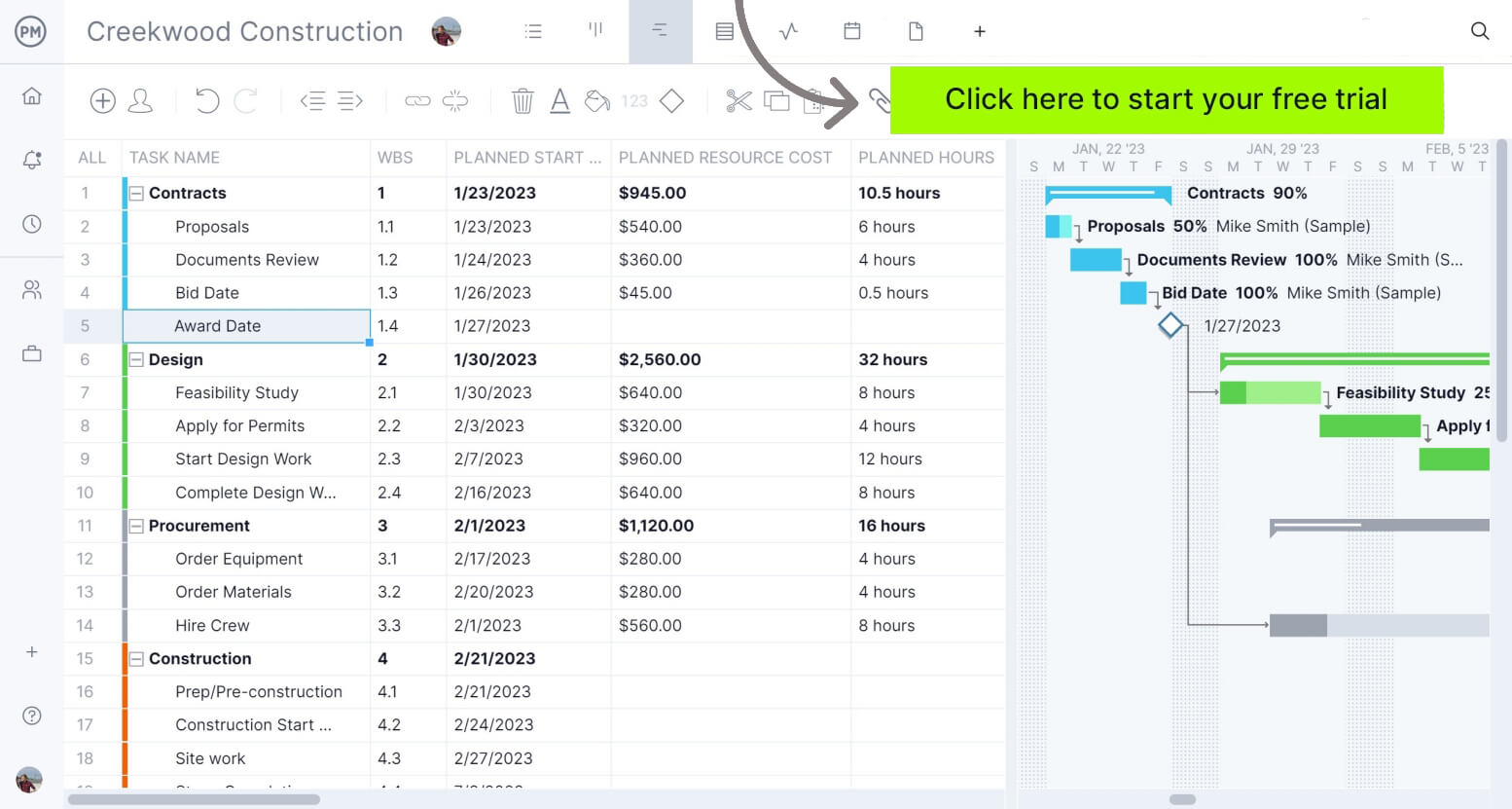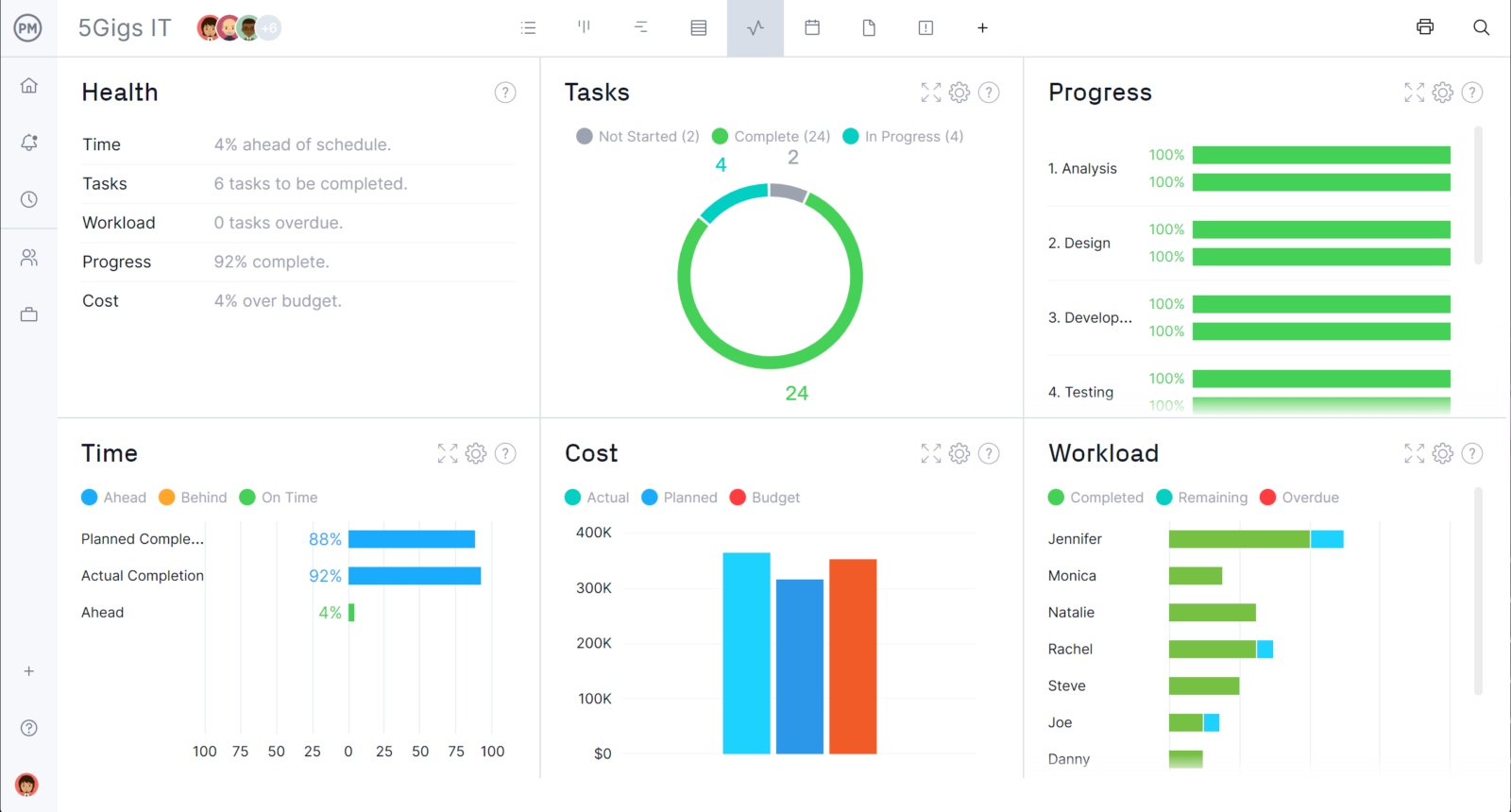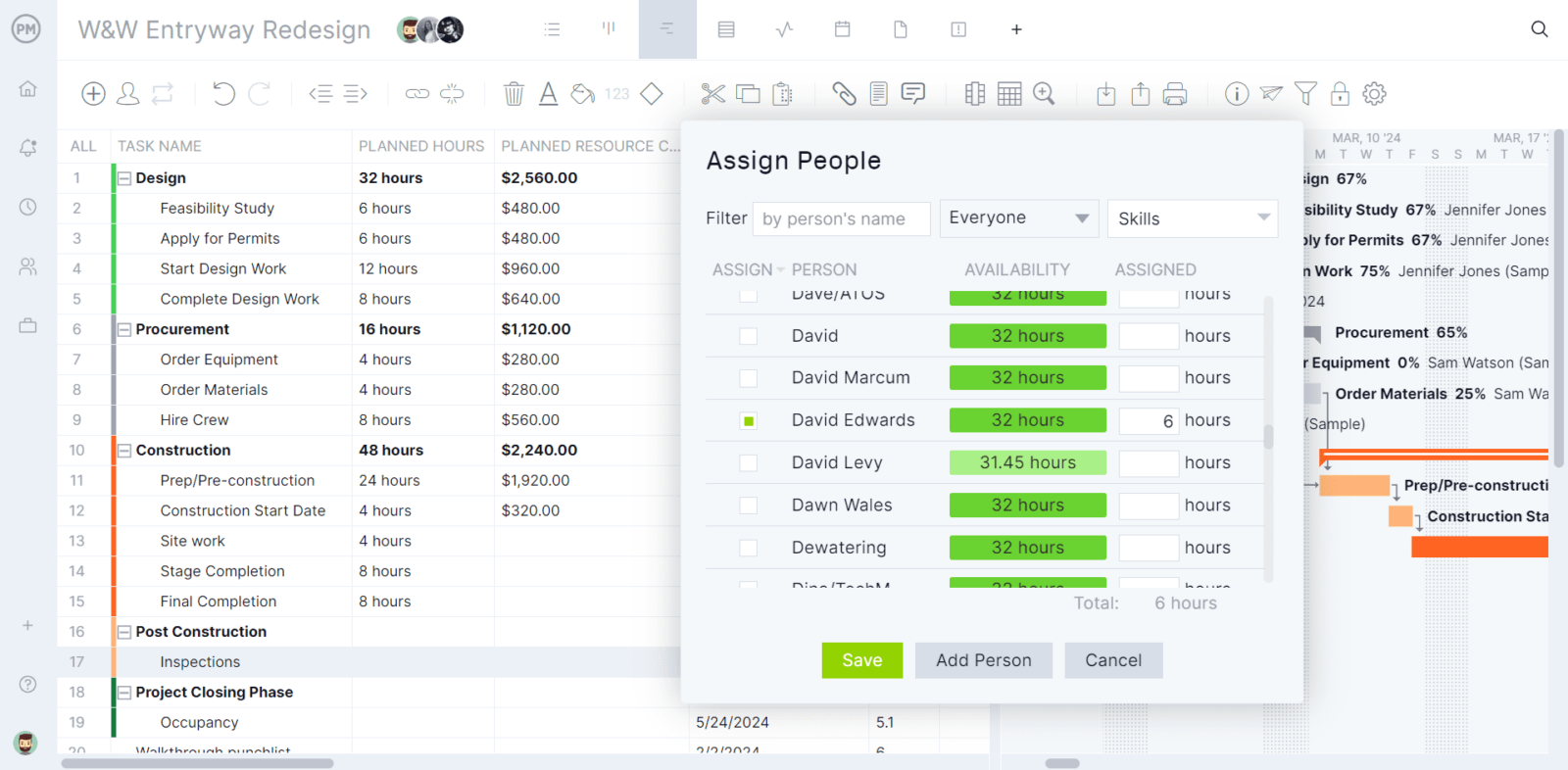Have you ever looked at a bridge, building or structure of any kind and wondered, “how did they do that?” They did it with construction management. Construction is, of course, a project, one that tends to be long, complex and involves many different parties to deliver.
In order to control all those moving parts, construction professionals use construction management for all project delivery methods. Let’s look at what construction management is and then go into some of the key elements. We’ll also discuss the process and offers some free templates to help in your next construction project.
What Is Construction Management?
Construction management is a professional service for project owners. It provides them with the management of the construction project’s schedule, cost, quality, safety, scope and function. Construction management is led by a construction manager, who reports to the owner and is tasked with delivering a successful project.
In order to schedule and budget the construction project while adhering to safety and security measures and managing risk, construction management requires project management methodologies and software. ProjectManager is online project management software that helps construction management plan, manage and track projects in real time. Robust Gantt charts organize tasks, resources and costs while linking all four types of dependencies and creating milestones. You can even filter for the critical path and set a baseline to track whether your actual progress is meeting your planned progress. Get started with ProjectManager today for free.


10 Key Areas of Construction Management
Multiple key areas make up the construction management discipline. By managing all of these separate areas a construction manager can deliver projects successfully. Here’s a quick overview of each of them.
1. Construction Scope Management
This is the process of defining and controlling what’s included in a construction project. It consists of planning, documenting and managing the work needed to complete the project while factoring in the budget and schedule. Key aspects of construction scope management include defining the project scope, creating a scope of work, developing a work breakdown structure (WBS) and managing changes.
2. Construction Cost Management and Budgeting
Cost management and budgeting helps ensure that construction projects are financially successful by effectively managing costs. Typically, the construction manager will help oversee this area of the project. There are several key focus areas, including cost estimating, budgeting, cost control and cost reporting. As a result, it helps reduce the risk of cost overruns, improves profitability, enhances decision making and increases stakeholder satisfaction.
3. Construction Resource Management
This is the process of planning, scheduling and managing the needed resources to complete a construction project. It includes everything from labor and materials to equipment, finances and time. Resource planning, scheduling and tracking all play a role in construction resource management with the goal of reducing project costs, improving project efficiency and boosting stakeholder satisfaction.
4. Construction Risk Management
All projects have risks, but especially construction projects. The project manager will work to identify, assess and mitigate potential risks that impact the project’s success. In construction projects, risks can range from material shortages to safety hazards to legal disputes. The more effectively risks can be managed, the better the project can stay on track while ensuring the safety of the workers.
5. Construction Planning and Scheduling
A construction management plan isn’t successful without planning and scheduling. These are two closely related processes that help define the project scope, identify the needed activities, determine their sequence and dependencies, estimate the durations and allocate resources. They work together to determine the overall approach and strategy for executing the construction project.
6. Construction Quality Management
In construction, quality management consists of both quality assurance and quality control. These areas work together to ensure the project meets the desired quality standards and specifications all while adhering to industry best practices. Processes involve planning, implementing and controlling activities to ultimately achieve a project that meets the client’s needs and expectations.
7. Construction Site Management
Construction site management focuses on organizing, directing and controlling the activities on a construction site to ensure the project is completed according to safety standards. It also helps the project stay on track so it finishes on time, on budget and within the desired quality standards. Key components of construction site management include site planning, site inspection, resource management, scheduling and coordination, cost control and quality control.
8. Construction Bidding
The bidding process in construction allows the construction manager to review contractors to hire for the project. Of course, price is a factor, but risk is also assessed. It’s important to look over the safety, financial and insurance resources of these contractors to ensure they’re professional and best suited for the job.
This process begins with a request for general contractors to bid on the project. These general contractors then get bids from subcontractors. There’s a back and forth as questions are answered about the project until the deadline when bids must be submitted and a contractor selected. This leads to contract negotiations and when agreed on, the contract is signed and distributed to the project team. The general contractor who won the bid will then make the final selection of subcontractors.
9. Construction Contract Management
Construction contracts are legally binding documents that are signed by the winning bidder and the owner and outlines the scope of work, risks, duties and legal rights for both parties. There are many different types of contracts, such as a lump sum contract in which the owner pays upon completion of the project. But there are many more, such as percentage rate, item rate, cost plus fixed fee and so on. You have to determine which contract is right for you and the job being done.
10. Construction Delivery Methods
There are five common delivery methods in construction projects. Design-bid-build, also known as traditional building, is probably the most used method. There are three phases: design, bid and build. This is often found in commercial construction projects and while lengthy, it gives owners the opportunity to work with architects and engineers to get a good price for the project.
Design-build (D-B) reduces the timeline that’s associated with design-bid-build by having a single party replace the designer and the contractor. This design-builder is usually an architect, engineer or contractor and works with the owner. This fosters better communication but puts many responsibilities on the shoulders of the design-builder.
Another delivery method is construction manager at risk (CMAR or CM at risk). It’s similar to the design-bid-build method, but the construction manager (CM) is hired by the owner to oversee the project. This is great for owners who need expert help managing the project and often allows the owner to remove themselves from the process.
Then there’s job order contracting (JOC), which works at completing a number of predefined construction tasks. It tends to be used in small-to-medium construction projects, such as repairs, renovations and maintenance. It’s ideal for short timelines and fixed budgets, but not new construction.
Multiple award task order contract (MATOC) is often found in military or government construction work. It involves long-standing contracts for multiple projects, all of which are under a single master contract. There could be multiple contractors at work, there could also only be one.
Construction Management Roles
There are three main parties involved in construction management. They are the owner, who is the one commissioning the work and funds or finances it; the architect or engineer, who is responsible for the design of the project; and the general contractor, who is the person overseeing the day-to-day operations of the project as well as managing the subcontractors.
Construction management is overseeing these parties and the overall project through the lens of the owner’s interests. Therefore, construction management interfaces with all three parties in order to make sure the project is delivered on time and within its budget, if not ideally under budget. The project must also meet the quality, scope and function expectations of the owner. This is accomplished by a combination of experience and education that directs the construction operations through the development of a detailed schedule and budget.
Project Owner
The project owner initiates the project, defines its purpose and is ultimately responsible for its success or failure. They help bring the project together and coordinate with all of the involved parties to guide the project from inception to completion. Keep in mind that the involvement of the project owner can vary depending on the project’s size and complexity.
Construction Manager
The construction manager is usually hired after the owner has finalized a design and is responsible for the day-to-day operations on the job site. They plan every stage of the construction project and make sure that the completed building meets quality and safety requirements while keeping to the timeline and budget.
General Contractor
The general contractor is responsible for taking the owner’s vision and architect’s plans to turn them into reality. They spend most of their time on the construction site and help with areas such as project management, cost management, quality control, risk management and more. The general contractor brings together the resources, manages the work and ensures the project is completed as it should be.
Site Supervisor or Foreman
The site supervisor or foreman is on the ground ensuring that the construction plans are brought to life both safely and efficiently. They help lead the crew and ensure everyone is working effectively. This role oversees day-to-day operations and enforces safety protocols. They also help with scheduling, progress tracking and communication.
Architect
The architect is the creative visionary for the team. They are involved from conception to completion to ensure the project is safe, functional and meets the clients needs. Their creativity, technical expertise and project management skills helps the building’s aesthetics and functionality.
Civil Engineer
Civil engineers are involved in all phases of the construction project, overseeing safety and functionality to help the project meet its goals. They evaluate the construction site, address any technical challenges that arise and coordinate with other project team members, problem-solving when needed.
Quantity Surveyor or Cost Manager
A quantity surveyor or cost manager in construction oversees all aspects of the project’s costs. This includes everything from the initial estimates to the final accounts to help the project stay within budget and deliver value for the money that’s going into it.
Health and Safety Manager
The construction health and safety managers is responsible for overseeing safety on the construction site. They help develop and implement safety plans while enforcing regulations. They are also working to promote a culture of safety consciousness on site to reduce the risk of accidents and injuries.
Procurement Manager
The procurement manager helps acquire the needed materials, services and equipment for a project. They work to guarantee that the right resources are available at the right time, at the right price and with the right quantity. These supply chain experts help navigate the ins and outs of sourcing and logistics to help keep the project on track.
Contract Manager
The contract manager ensures that all parties in the project understand their obligations and are fulfilling them as needed. They help bridge the legal and commercial complexities of construction contracts while protecting the company’s best interests.
The Construction Management Process
Construction management follows project management methodology in order to deliver the project on time and under or within the agreed-upon budget. After the bidding process and the contract has been signed, it’s time to build. Construction projects have phases, and there are five basic phases to the construction management process.
Initiation
Before any planning is started, an objective for the construction project has to be decided upon. There is also a need to do a feasibility study to ensure that the construction is even viable. That is, there’s a return on investment and the project can be delivered on time and within a reasonable budget. You’ll also need to have a schematic design at this phase. Once this is done, a project initiation document (PID) is made, which will provide the groundwork for the construction plan.
Preconstruction
This first step is to assemble a project team who will look at all the work that must be done in order to complete the project. A work breakdown structure (WBS) is often used to divide the larger job into small, more manageable deliverables and tasks. Time is planned in a schedule of activities that includes the costs for executing tasks and the resources needed to do them. This is called preconstruction. At this point, the schedule, budget, risk management plan and communication plan are all finalized. Though, these are living documents that must be reviewed and revised throughout the life cycle of the project.
Procurement
Now, the project team orders, purchases or rents everything it needs for the construction project. This includes tools and services that’ll be necessary to complete the project. Depending on the scope of the project, this can be demanding. Good communication is vital between the owner, contractor and vendors to ensure everything is done properly. Poor communication leads to bad purchasing and inventory that’s lacking or overstocked; either scenario is bad for business.
Construction
This is when the project is executed. During this phase of the process, the general contractor and subcontractors carry out all the planning and procuring of resources that had been done in the previous steps. The construction manager, architect, engineers and project manager will all work together to perform quality control inspections, respond to requests for information (RFIs) and review and approve technical submissions. This is all done to make sure the construction meets the design requirements while keeping to schedule, budget and quality.
Post Construction
The final phase involves a punch list, where the contractor and owner look over the job and catch errors or items that still need to be completed. Once the project has been successfully delivered, however, there’s still work to do. Resources are demobilized, rentals are returned, the worksite is cleaned and subcontractors’ contracts are closed so they can move on to other projects.
Free Construction Management Templates
While project management software is better suited to managing the processes of construction management, many still work off of spreadsheets. It’s not recommended, but if one isn’t ready to upgrade, there are construction management templates.
ProjectManager is project management software but also a site in which dozens of free project management templates for Excel and Word can be downloaded for free. The following are free of construction-related free templates.
Construction Proposal
Since construction projects are based on the bidding process, construction management needs proposals to prove they are the best choice for the job. Our free construction proposal template for Word gives you space to outline the scope of work, cost and payment, schedule and much more.
Construction Estimate
The more accurate your estimate, the more likely you’ll profit from construction management. Better forecasts come from research and using our free construction estimate template for Excel. With the free template, you can document the direct, indirect, labor and material costs of your construction project during the bidding process.
Construction Schedule
When planning all the activities necessary to complete a construction project on time you need our free construction schedule template. See all your tasks on a timeline to track deliverables, manage resources, add milestones, filter for the critical path, link all four dependencies and track your budget to avoid overspending.
Construction Daily Report
Every day a report must be filed to document the work done and set up for the work coming the next day. Our free construction daily report template for Excel captures the work you did, whether it was completed on schedule, notes who and what is needed to finish the job, to list visitors and the weather conditions.
ProjectManager Helps With Construction Management
Templates are fine, but you may get frustrated with them fairly quickly. That’s because they’re static documents that don’t automatically update or lend themselves to collaboration. ProjectManager is online project management software that has automation and real-time data for greater insights into your project and connects teams across departments, whether they’re in the office or the field.
Monitor Progress in Real Time
Construction management is all about keeping on schedule and not overspending. To make sure you’re following the construction plan, you need to use our real-time dashboard. It captures, calculates and displays easy-to-read graphs and charts on time, cost and four more project metrics. There’s no complicated configuration as with lightweight tools. Our live dashboard is up and running the moment you open the software.
Manage Resources to Stay Productive
Keeping track of your resources is another responsibility in construction management. Our resource management features allow you to see the availability of your crew to ease scheduling and then monitor their workload to keep them working at capacity. Use the color-coded workload chart to see who is overallocated or under-allocated. Then balance the team’s workload right from the same chart, increasing productivity and avoiding burnout.
Manage your team’s hours with secure timesheets. They’re easy to submit and show how many hours each team member has spent on their tasks. You can set recurring tasks and automate workflows to further make work more efficient. There are also customizable reports that give you details on project status, variance and more. We have what you need to manage your construction project.
ProjectManager is award-winning software that empowers teams to collaborate and gives managers transparency to keep them productive. Our flexible tool works for traditional, agile and hybrid methodologies. Join teams qt Avis, Nestle and Siemens who are using our software to deliver success. Get started with ProjectManager today for free.









